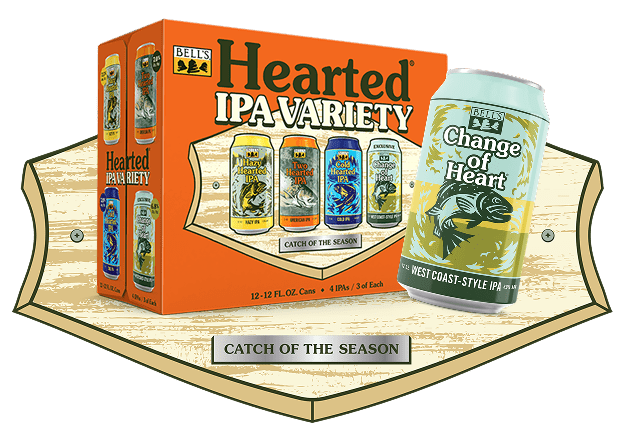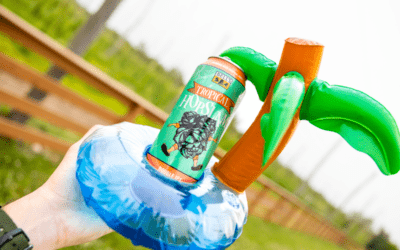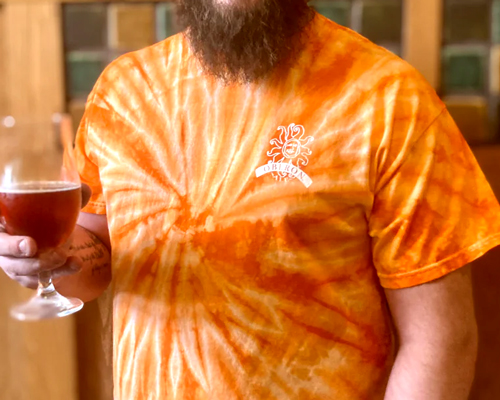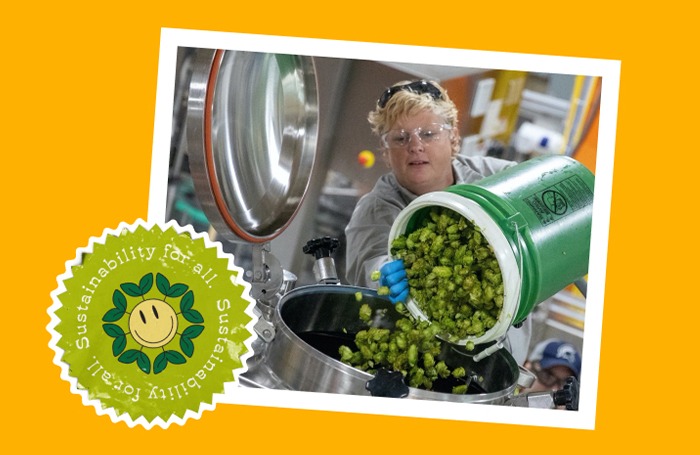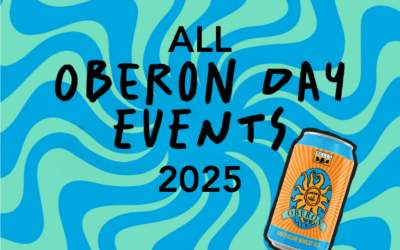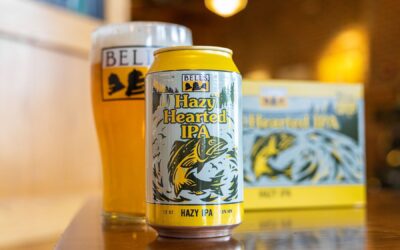Let’s be honest: sometimes a beer just nails the vibe. Tropical Hopslam is one of those beers. ...
Pulling inspiration everywhere around you: Get to know Bonnie
This is the fourth interview in a series that spotlights coworkers who make Bell’s the brewery it is. This interview has been edited for length and clarity.
As we continued our series of coworker interviews, we grabbed a shifty with Bonnie, a lifelong gardener, hop grower, and land steward. We sat down for a beer in one of the gardens she helped create at the brewery, discussed the upcoming hop season, Sideyard, and being inspired by repurposing.
Bonnie, thanks for joining us today.
My pleasure.
So, we’re here on a beautiful afternoon at the Comstock Brewery, drinking a shifty in a garden. Tell me a little bit about this space you helped create.
It started during the pandemic because we couldn’t gather indoors, so we made this area outside. We set into the prairie and plunked some hop poles in, and then added shade sails. It looks festive and brightens up the whole corner of the building.
I love coming to the brewery and seeing the projects you, Liz and Josh are working on. Tell me about some of them.
Gosh. There’s the mini apple orchard. Across from that is the Community Garden for coworkers and their family and friends. It’s mostly vegetables and herbs, but we’ve done some cut flowers. There’s a monarch butterfly way station, that’s registered as the Eccentric Nectar. The beehives are empty right now — I’m filling ’em up at home. I have a bunch of bees at home that, like, what do I do with all these bees? I’m an accidental good beekeeper.
Apples, bees, vegetables, and beer… and there’s the hop yard, too!
Yes, at the other end of the brewery, we have a two-and-a-half acre hop yard that we’ve been growing hops in for the past nine years.
You’ve done so many cool and interesting things here over the years, how did you arrive here at Bell’s?
I came to Bell’s first helping the land steward team with the hop yard as a temp employee, which was awesome because I used to work in hops professionally. From there, I just started working on other projects around the brewery. I’m a lifelong gardener, grew up working in greenhouses, and did landscaping services with my husband. So, I just started weeding everywhere and maintaining the grounds the best I knew until they hired me full time.
So, you weeded yourself into a job?
Pretty much .
You’ve been involved with craft beer in Michigan long before you were a Bell’s coworker. How did you get your start?
I was working at a greenhouse near Comstock and lived in downtown Kalamazoo. I had just recently turned 21 and went to this great little place on the way home called the Corner Bar with a friend of mine from the greenhouse. We shared a pitcher of Best Brown for $8. I just remember the flavor was so full and pleasing: it wasn’t like water, but had a different purpose, you know? It was just to be enjoyed. It really made me feel like: I love this place. And so, then, I just made friends there and was introduced to a lot of different beers from around the world.
There weren’t very many breweries open in Michigan back then, so as they started to open one by one by one, I had to go check them out. When small breweries open, it’s like somebody inviting you into their house: It reflects their personality and tastes. I love seeing what people come up with and all the different flavors. I don’t know, it’s just a happy world. It’s a loving world, too. People in craft beer generally stick up for each other, and they take care of each other.
How did you go from enjoying beer to helping grow hops?
My cousin’s husband was a brewer, so they eventually asked if we would be interested in growing hops for their brewery. She was like: I know you love beer, and you know a lot about plants. I didn’t know much about it but looked into it. That was like early 2000s.
I’ve observed several hop seasons here at the brewery. It’s a lot of work. Why do brewers like to grow hops when you can just order them?
It’s the connection and challenge of growing them. If you’re a brewer or a plant geek, there’s a challenge there: I put my hands to this and here’s the end product and I can use it. It’s a point of pride and there’s a lot of connection there. I mean, there’s not an easy plant to manage, right? So, it’s a lot of work, but so is brewing.
What is a typical hop season like here at Bell’s?
Well, we start in the winter, remembering what the past season was like . And we start planning for the next season, ordering ropes and other tools. But it really starts when the hops begin to poke out of the ground a little bit. Once they’re trimmed a few times, we’re ready to tie ropes to the top of the trellis, and we stick ’em in the ground. Sometimes the hops find the rope before we show it to ’em. And then, we pretty much watch ’em grow through the summer while we check their health. Then in August, it’s harvest time. A bunch of coworkers from the brewery join us to help. It’s a lot of work, but fun. And then, it’s added to Sideyard.
The release of Sideyard is one of my favorite times of year. Why do you think we invest so much into the limited release of a harvest ale?
We’ve always had really good relationships with the growers of raw ingredients that go into our beers. I think it’s important to show that we know where they come from, and to show customers, clients and other brewers that we’re invested. And I think it’s also really good for our coworkers to come out and see what it looks like. Not everybody gets to go to a hop yard. It’s a great educational piece, and it’s a way to be more connected to our beer.
One thing we’ve focused on over the years is the responsible use of resources. How do you see what you do fitting into that?
We reuse most things that we make around the brewery. Like, the idea for the shifty garden came out of extra hop yard poles. We use what we have first and repurpose that. Like these benches, they were made out of the cradles used for packaging and transporting our 800 bbl tanks. It’s responsible, but also creative innovation to be like “what cool stuff can we with what we already have?”
I’ve always thought what you do is a visual representation of the ethos of work that’s done inside the brewery. It can be difficult for me to appreciate how a valve is repurposed from one machine to another, but I can understand taking extra hop poles and using them to create shade in a garden.
Totally. It’s a fun and creative way to approach life. And it’s cheaper <laugh>.
So, your job title is “land steward” — what does that mean?
I say we take care of the land that is Bell’s, but also the people. Any person who comes on campus, we’re thinking about how comfortable, safe, and inspired they feel. One day, I was plowing snow for our tours entrance, and it was perfect packing snow, so I made this hop cone out of snow and put it out there. We like to take care of people in a lot of different ways. We want everyone who visits or works here to feel like they are in a good space.
You mentioned making sure people who visit the brewery feel inspired… What does Inspired Brewing mean to you?
It means throwing a bit of caution to the wind and going with your gut on making something that’s just going to be freaking cool. It’s making a beer with hops grown in a yard next to the brewery, or repurposing packaging materials to make a bench. It’s pulling inspiration from everything around you and making something new.
What inspires you?
My favorite thing is to sit in my backyard mostly, but any garden as long as I can have a beer, and sit and watch the flowers and the birds. I just get ideas, that’s the best inspiration. My favorite thing is backyard beers. Those are the spaces I love. I love feeling like you can make these little nooks in places and then just enjoy them. Yeah. Getting a little bit of a buzz from a really good beer and looking at pretty colors and plants.
Well Bonnie, this was a great chat. I’m more inspired than ever to create a space in my backyard. Can’t wait to see how the hops turn out this season.
Related Posts
All the 2025 Oberon Day Events
As Oberon Day approaches, several special beer tappings and special events are planned across the country to celebrate its return! Here...
Hazy Hearted: A Modern Go-To IPA Bursting With Fruity Hoppy Flavor
If you catch our Brewmaster Andy Farrell out and about enjoying a beer, it’s probably a Hazy Hearted. “Hazy Hearted is what I drink at...
Inspired to craft creative solutions: Get to know Erica
This interview is part of an ongoing series that spotlights coworkers who make Bell’s the brewery it is. This interview has been edited...

